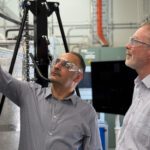Curtin University planetary scientist Dr Katarina Miljkovic will take part in NASA’s Mars InSight Mission to study the crust and interior of the Red Planet. Dr Miljkovic is the only Australian involved with the project.
The InSight (Interior exploration using Seismic Investigations, Geodesy and Heat Transport) Mission will reveal what lies under the red planet’s surface so that we can understand the formation and evolution of Mars and other rocky planets in our inner solar system, such as Earth. The robotic lander is now Mars-bound, after a successful launch on May 5.
It will be the first thorough check-up Mars has had since it formed 4.5 billion years ago and will measure vital signs such as its pulse (seismology), temperature (heat flow), and reflexes (radio science).
Dr Miljkovic, an Early Career Research Fellow at Curtin University’s School of Earth and Planetary Sciences, said the stationary lander will measure seismic activity by waiting for a meteoroid to crash into the surface of Mars causing an earthquake – or more accurately, a “marsquake”.
“My role is to understand how small meteoroid bombardment occurs on Mars and what seismic effects it has on the Martian crust, by developing numerical models,” Dr Miljkovic said.
“InSight records the seismic quakes when impacts actually occur on Mars and my model helps us to understand the structure of the crust and core of Mars by constraining the properties associated with the impacts.”
John Curtin Distinguished Professor Phil Bland, from the School of Earth and Planetary Sciences at Curtin University, said Dr Miljkovic’s selection as the only Australian scientist on the mission reflected both her individual achievements in the field of planetary science and those of Curtin University.
“Curtin University is a leader in space and planetary science in the southern hemisphere. We have a well-established formal relationship with NASA and we are actively shaping our State and nation’s emerging space agency capabilities. Katarina is a world-leader in the field,” Professor Bland said.
“As such, it is no surprise that this particular Curtin researcher has been selected for a scientific role as significant as being part of NASA’s Mars InSight Mission.”
Professor Bland said that with InSight’s launch, NASA is also sending the first CubeSats to deep space as part of a separate experiment called Mars Cube One, adding that plans were well underway for Curtin University to launch its own CubeSat into low Earth orbit.
The InSight CubeSats are designed to test new communications and navigation capabilities for future missions and may aid communications during the InSight Mission.
InSight was the first planetary mission to take off from the West Coast of the United States and launched from Vandenberg Air Force Base in California aboard a United Launch Alliance Atlas V rocket.
It is expected to take about six months for the InSight lander to reach Mars where it will then spend about two years performing surface operations.



